Succulents are all the rage among plant enthusiasts, with good reason. They are usually low-maintenance, drought-tolerant plants that come in a virtually endless variety of structures and colors.
Whether it’s the jade plant, aloe vera, or the endless varieties of rosette succulents, there is something for everyone in the succulent world. Not only are these plants easy to care for, but normally they are also relatively easy to find at nurseries and retailers.
But then other succulents are fascinating but much more challenging to locate. Some are rare because they don’t readily propagate. Others are rare because they are more difficult to care for than average succulents, so nurseries and retailers can’t stock them.
With advances in tissue culture, some of these hard-to-find succulents are becoming slightly less rare, but none are super easy to come by yet.
Let’s explore nine of these rare types of succulents!
1. Ruby Necklace (Othonna capensis)
This woody-stemmed succulent begins with small, plump green leaves that resemble small pickles. In fact, it’s often referred to as “little pickles” or “string of pickles” while the leaves are green.
The more common name, ruby necklace, comes from the trailing foliage that turns a beautiful red/purple hue in dry conditions.
Native to the Eastern Cape province of South Africa (where it is called Bobbejaankool), the ruby necklace is a creeping, low-growing succulent that forms a mat. The plant only grows about four inches tall, but can spread as wide as 16 inches on the ground.
Small yellow flowers bloom in the summer when there is adequate sunlight.
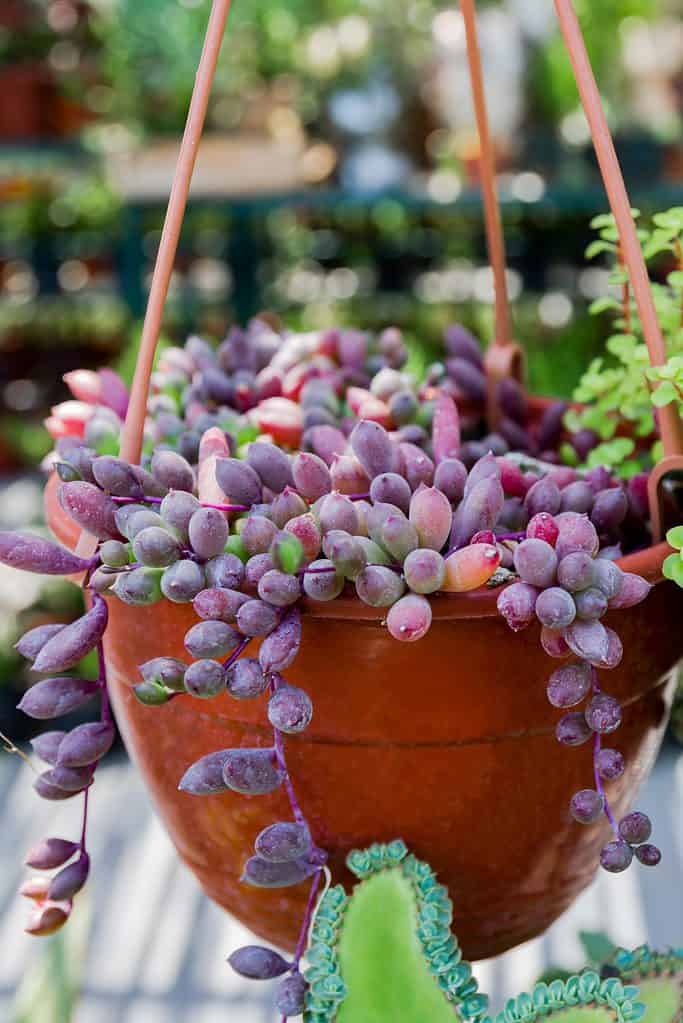
Ruby necklace with trailing foliage in a hanging pot.
©Yasin Caglayan/Shutterstock.com
2. Baseball/Basketball Plant (Euphorbia obesa)
The references to a baseball or a basketball (the two common names are used interchangeably) come from this succulent’s signature round shape.
Native to South Africa, the baseball plant can reach a height of 12 inches, but it doesn’t get there quickly. It can take six years or more for the plant to reach maturity.
Baseball plants bloom in mid-summer with lovely yellow flowers.

Round baseball plant in a pot.
©kikpokemon/Shutterstock.com
3. Plover Eggs Plant (Adromischus cooperi)
This succulent features blotchy spots, just like a plover’s eggs, hence the name. The spots on an actual plover’s eggs are usually brown, while the blotches on this plant are redder in color.
Also, while plover eggs are considered a delicious delicacy, the plover eggs plant is toxic’So don’tt make it into an omelet!
This succulent with its fleshy, spectacled leaves remains small, maxing out at four inches tall.
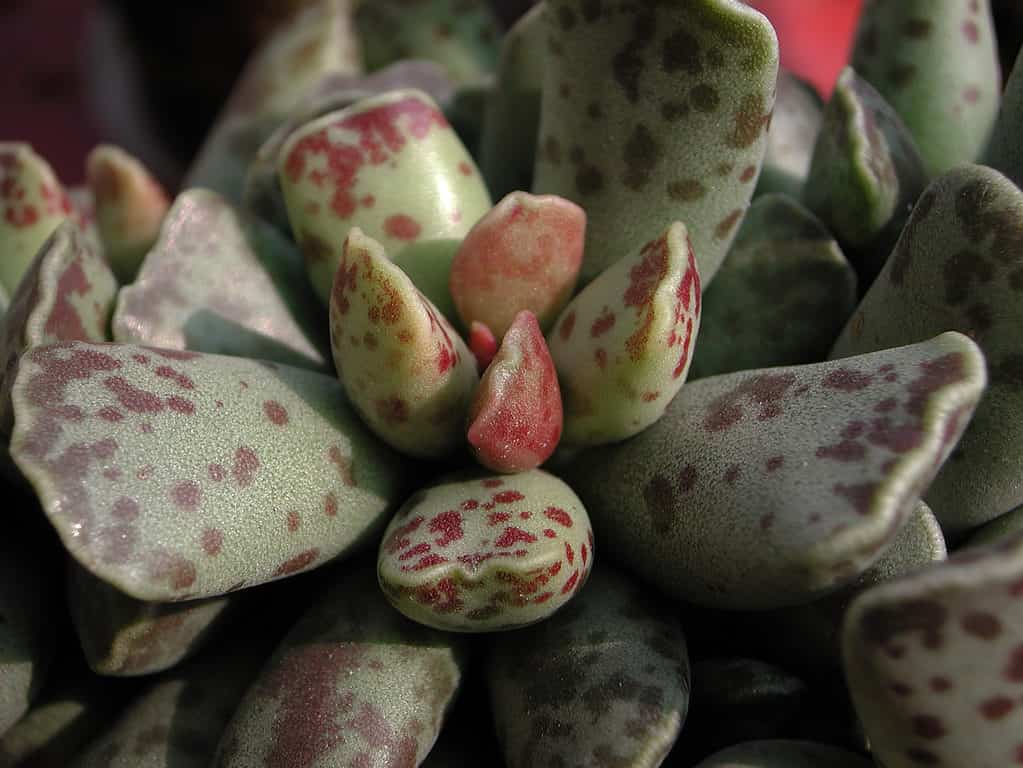
Close-up of a plover eggs plant with pale green leaves and dark red spots.
©simona pavan/Shutterstock.com
4. Pebbled Tiger Jaws (Faucaria felina subsp. tuberculosa)
This rare plant is also endemic to South Africa, and is one of the most interesting (frightening?) succulents around.
The common name refers to the appearance of a tiger‘s jaws opened wide. Each leaf is covered with white, wart-like bumps. The edges of the leaves are also lined with white, teeth-like structures.
The plant grows to a maximum height of six inches tall, and its fearsome appearance is tempered when beautiful yellow, daisy-like flowers bloom in each clump of leaves.

Close-up of a pebbled tiger jaws plant, showcasing its “teeth.”
©Pavaphon Supanantananont/Shutterstock.com
5. Calico Hearts (Adromischus maculatus)
This succulent is another native South African plant, where it is found on the rocky slopes of the Langeberg Mountains in the Western and Eastern Cape Provinces.
Also knowns as the “chocolate drop,” the calico hearts plant is another low-growing succulent that forms mats on the ground. The oval, wedge-type leaves look somewhat similar to the leaves of a flapjack plant. They grow to about three inches long and display a mix of green, gray, and brown colors. In dry conditions, the leaves take on more of a red hue, while the spots are known to turn a deep purple.
It is a winter-blooming plant featuring small, greenish-yellow flowers.
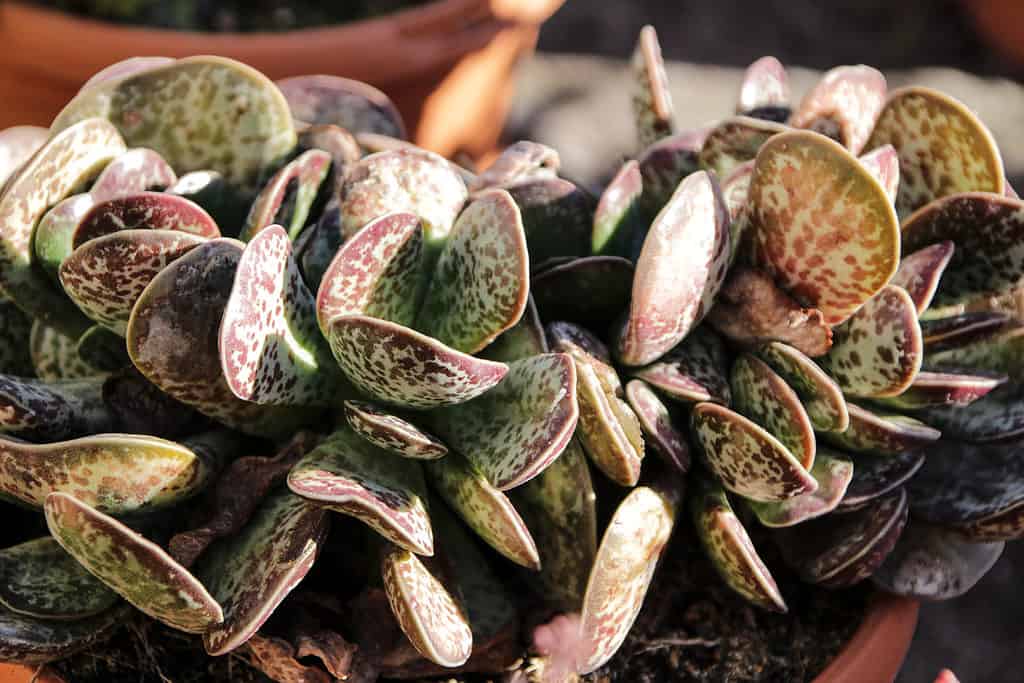
The grey-green, flat, oval-shaped leaves of the calico hearts plant with signature purple spots.
©Sonia Bonet/Shutterstock.com
6. Little Jewel (Pachyphytum compactum)
Native to Mexico, this plant features plump leaves, as do all members of the genus Pachyphytum (which means “fat plant”). The narrow veining near the surface of the thick leaves gives this succulent a unique appeal. It bears a resemblance to the facets of a cut gemstone, giving the plant its common name.
The leaves are bluish-green, but the violet veining shows up when the plant is “happily stressed” by the sun, dry conditions, or cooler temperatures.
The leaves also have a waxy coating called farina, which is sensitive and can be damaged when handled carelessly.
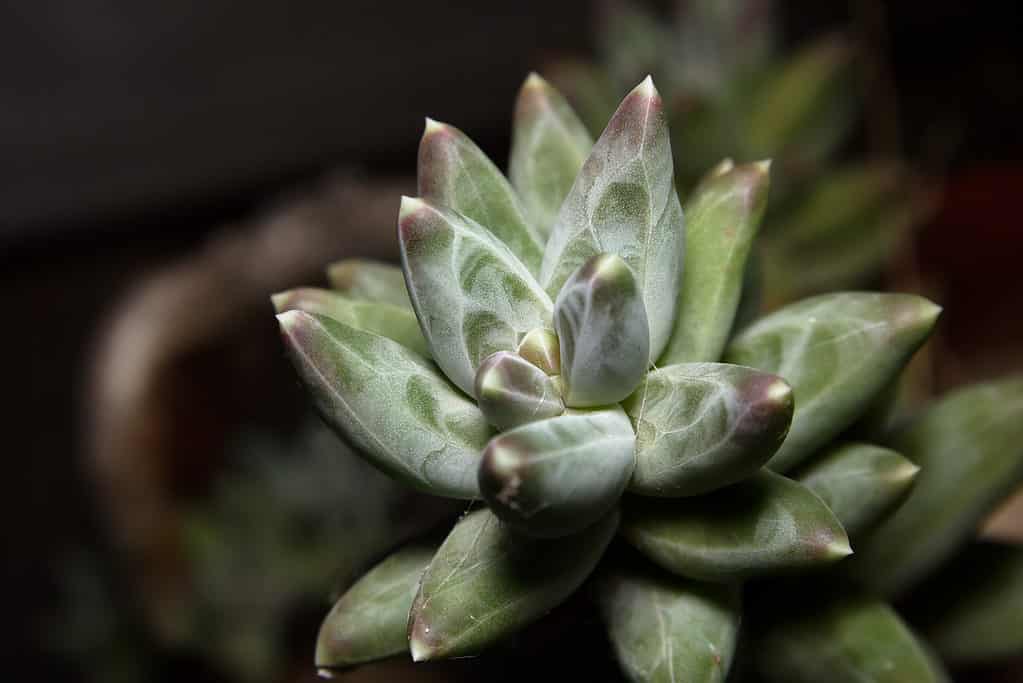
The bluish-green leaves with violet veining of the little jewel plant.
©iStock.com/Andrew Waugh
7. Mexican Hens and Chicks “Topsy Turvy” (Echeveria runyonii)
Echeveria runyonii, more commonly known as Mexican hens and chicks “topsy turvy,” is native to the state of Tamaulipas in Mexico.
The leaves of this plant really make it stand out among other rosette succulents due to their unique growth habit. The silverish-green leaves form a downward fold along the length of the leaf. The tips of the leaves then curl up, pointing back toward the center of the plant.
The plant flowers in the fall, as a 6-8 inch stem grows upward and then blooms with star-shaped orange or yellow flowers.
Mexican hens and chicks “topsy turvy” produces offsets that grow together to form a carpet of rosettes along the ground.
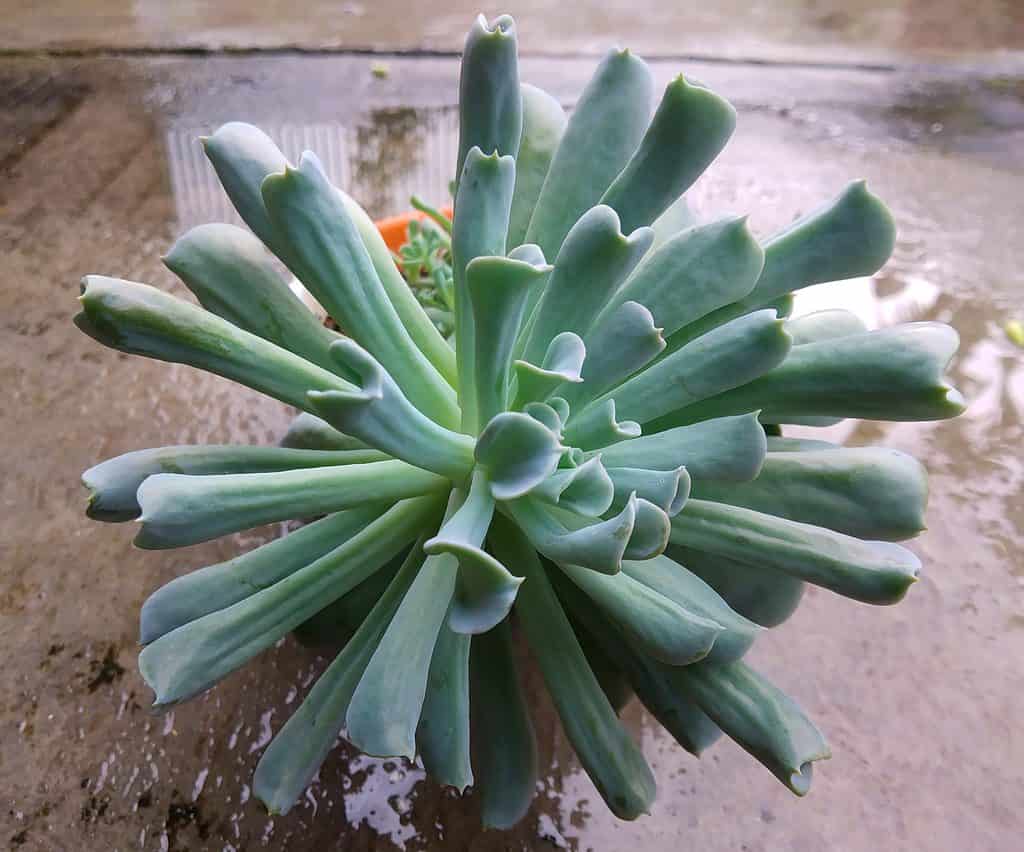
The inversely-folded leaves of the Mexican hens and chicks “topsy turvy” plant.
©heyrama/Shutterstock.com
8. Crinkle Leaf Plant (Adromischus cristatus)
Also known as “key lime pie,” this fan-shaped plant is native to the Eastern Cape of South Africa. It features fleshy green leaves measuring about two inches long and one inch wide. The leaves are covered with tiny hairs, giving the plant an overall fuzzy appearance.
The leaf-ends form a crinkle, giving the plant its common name. The crinkle leaf plant flowers in the spring, when a tall stem blooms with small, white flowers with hints of red.

Crinkle leaf plant in a pot.
©Satakorn/Shutterstock.com
9. Giant Quiver Tree (Aloe pillansii)
It may not look like it, but the giant quiver tree is actually a succulent. This rare species is a member of the Aloe genus, and all aloes are succulents.
This tree aloe is endemic to arid parts of South Africa and southern Namibia. The word “giant” in its common name is fitting, as the tree can grow from 30-50 feet high in the wild, making it one of South Africa’s largest tree aloes. (It does grow much smaller in cultivation, though.)
The smooth, thick trunk has few branches. It features a small number of plump, silver-gray leaves with little yellow teeth along the edge.
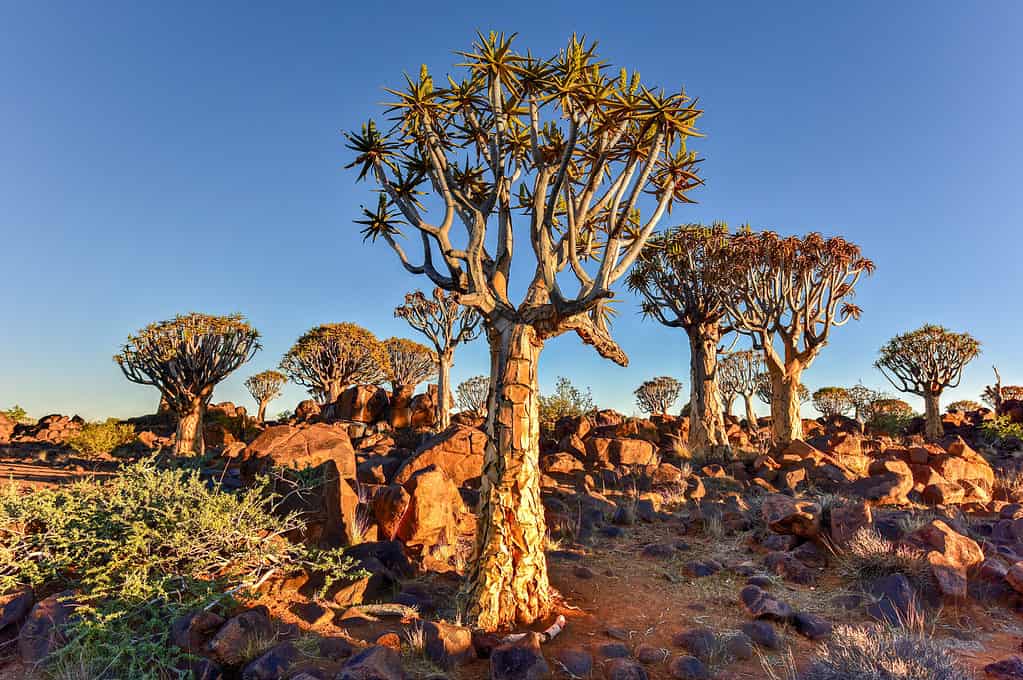
Giant quiver tree forest in Namibia at dawn.
©Felix Lipov/Shutterstock.com
Care
As stated earlier, these succulents are rare for a variety of reasons. Some of them are fairly difficult to care for in comparison to most other succulents, which thrive on neglect.
For this reason, it’s not possible to give universal care instructions for these rarities. However, should you find one (and bravo to you if you do!), carefully research and consider the care requirements needed for the plant to thrive. It may be more than you are willing or able to provide.
While we all want a unique plant to make our garden stand out (and possibly make neighboring gardeners jealous), we also need to make sure we can responsibly care for rare plants. They are rare for a reason, but let’s make sure that the reason isn’t us.
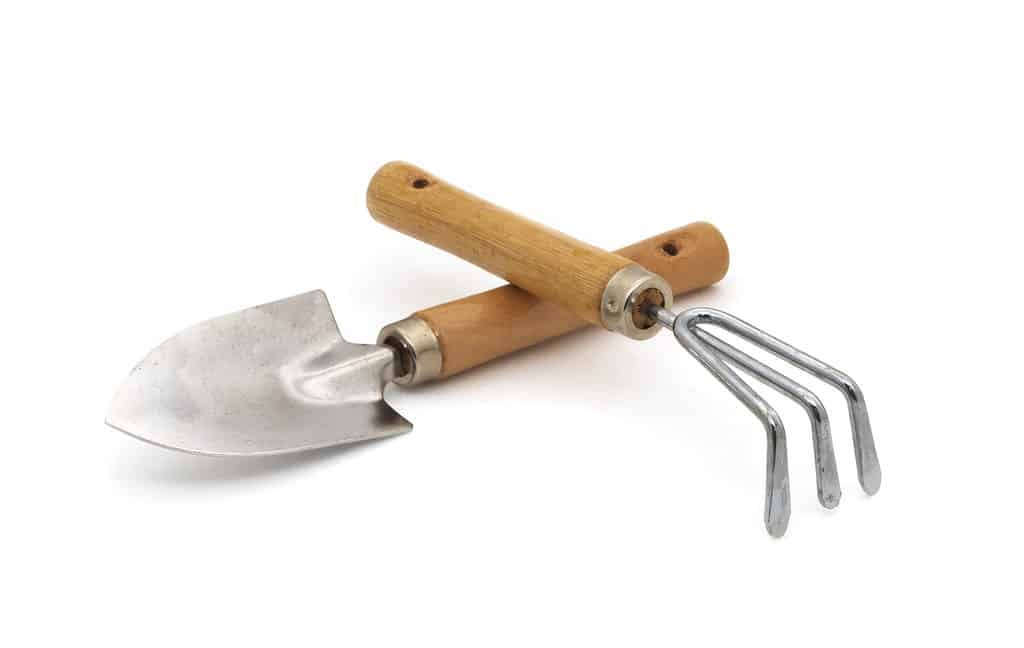
Spade and gardening rake.
©LubaShi/Shutterstock.com
Searching for Rare Succulents
With the explosion in popularity, more gardeners than ever are seeking new succulents. While there are many positives to this spread of succulent fandom, some negatives that have emerged.
The new demand for unique and rare succulents has had a deleterious impact on some species in the wild. Many rare species are illegally harvested and sold in underground markets.
When seeking out a rare succulent, it’s important to make sure that it was ethically sourced. It’s incumbent on today’s succulent aficionados to ensure that the next generation of gardeners will have the same pleasures provided by these amazing plants.

When seeking out a rare succulent, it’s essential to make sure that it was ethically sourced!
©Krakenimages.com/Shutterstock.com
The photo featured at the top of this post is © AlessandroZocc/Shutterstock.com
Thank you for reading! Have some feedback for us? Contact the AZ Animals editorial team.







